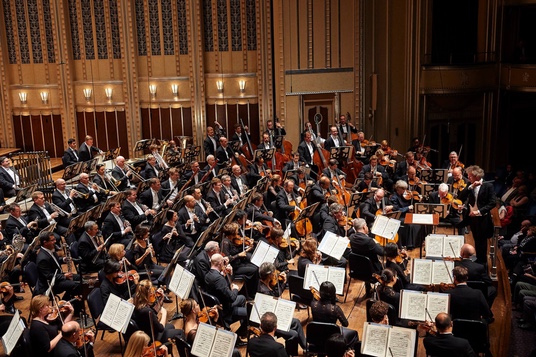
The 11/25-27 Cleveland Orchestra program, “Beethoven’s Fateful Fifth,” under the baton of Jaap van Zweden, consisted of Benjamin Britten’s Sinfonia da Requiem, Wolfgang Amadè Mozart’s Piano Concerto No. 23 and Ludwig Van Beethoven’s Symphony No. 5, a trio that brought continued applause and vocal accolades from the sold-out opening night audience.
A mid-20th century Britten composition, Sinfonia da Requiem was commissioned by the Japanese government to commemorate the Empire’s 2600th anniversary. Japan rejected the music because of the use of Latin titles for its three movements and for its somber overall character. Ironically, the first performance of Requiem took place in New York in March 29, 1941, about eight months before Japan’s attack on Pearl Harbor, which started the Asian phase of the Second World War.
The 20-minute piece was later incorporated into War Requiem, a work for chorus, orchestra and soloist, which is one of pacifist Britten’s masterpieces. Requiem is one of Britten’s purely orchestral work, and was his first major work that did not include a soloist. Opening with thunderous drumbeats of impending storms and doom, it often has overtones of dissonance and surprisingly comes to a quiet ending, a solemn prayer for the dead. The orchestra was in complete command of the composition, enveloping Severance Hall in the multi-textured work.
Russian-born, and both Russian and Cleveland Institute of Music-trained, pianist Daniil Trifonov wrapped the audience in his beautifully conceived rendition of Mozart’s Piano Concerto No. 23. His long fingers made love to the keys, flawlessly coaxing exquisite sounds from the instrument. Physically swaying, a smile often creasing his face, he was totally immersed in the composition and in total sync with both van Zweden and the orchestra. The audience responded to his performance with three standing ovations and got rewarded with a short solo encore by Trifonov.
Running about 25 minutes, the piece consists of three movements. Mozart, who is credited with giving the piano concerto a whole new meaning, was a master at alternating orchestral and solo passages. He is credited with creating a “piano concerto capable of expressing the most diverse characters and feelings, from grandiose and festive to lyrical and intimate, with innumerable shadings in between.” Trifonov and the Orchestra superbly highlighted the beauty of this Mozart work.
The Cleveland Orchestra first played Beethoven’s Symphony No. 5 during its inaugural season in 1919. It has been one of their mainstays, both locally and on tour, since. Considered the most famous of all symphonies, few ever get tired of hearing it from its first four-note theme, which matches Morse code’s dot-dot-dot-dash pattern tapping out “V,” to its loud, powerful and triumphant finale.
The orchestra, as should be expected from one of the world’s great musical assemblages, played each of the four movements in a concise, focused and glorious manner. As my grandson, a Jacob School of Music at the Indiana University award-winning composer and pianist stated, “The performance was perfectly executed.” What a way to bring to a close a very special evening of music.
The orchestra welcomes Wesley Collins as principal viola and violinist Jessica Lee as assistant concertmaster.